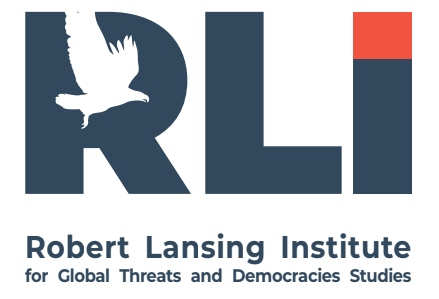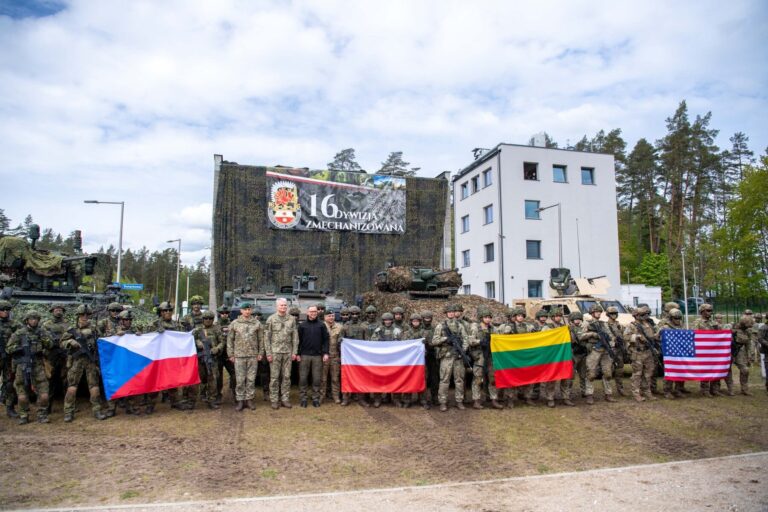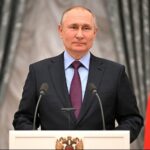- A Russian offensive against the Suwałki Corridor would represent a direct assault on NATO territory and trigger Article 5, initiating full-scale war between Russia and the Alliance.
- The most plausible trigger would be a diversionary move amid a failing Russian campaign in Ukraine, or a contingency following political or military collapse in Belarus.
- Russia’s likely goals would include severing the Baltic states from the rest of NATO, deterring further NATO expansion or military aid to Ukraine, and gaining leverage for negotiations.
- NATO’s credible deterrence posture in the region is improving, but still vulnerable to a surprise hybrid or short-warning kinetic attack.
- A conflict in the Suwałki Gap would be short, intense, and catastrophic, with high risks of escalation to nuclear thresholds, especially if Russia perceives defeat as existential.
- Preventing war requires forward-deployed NATO troops, airpower readiness, enhanced Polish-Lithuanian coordination, and reinforcement of Baltic defense infrastructure.
I. Strategic Importnce of the Suwałki Corridor
The Suwałki Corridor is a narrow, 65-kilometer strip of land linking Poland to Lithuania between Belarus and Kaliningrad, two heavily militarized regions under Russian influence. It is the only land route for NATO forces to reach Estonia, Latvia, and Lithuania. Control of this corridor could isolate the Baltic states and create a fait accompli, forcing NATO into a high-risk decision: escalate or accept defeat.
II. Possible Timing of a Russian Offensive
1. Wartime Contingency
- If Russia faces imminent defeat in Ukraine, Putin may seek to widen the battlefield to distract NATO, delay Ukrainian offensives, or alter the political narrative.
- A NATO-Ukrainian military integration breakthrough, such as fast-tracked NATO membership talks, could serve as a pretext for escalation.
2. Belarus Crisis
- A collapse of the Lukashenko regime or civil unrest in Belarus could prompt Russian intervention under the guise of “security,” positioning forces for a strike from Belarusian territory.
3. U.S. Political Transition
- A U.S. presidential election cycle, especially a Trump victory with isolationist rhetoric, may embolden Russia to act while Western unity appears uncertain.
III. Russian Objectives
- Sever land connection to the Baltics and establish a Russian-controlled buffer zone.
- Force NATO to negotiate on Russian terms, including halting further expansion and cutting military aid to Ukraine.
- Undermine Western resolve and fracture NATO political cohesion.
- Test NATO’s Article 5 commitment without immediate full-scale war (e.g., via hybrid or proxy forces).
IV. Potential Military Scenarios
Scenario A: Hybrid Incursion
- Russian or Wagner-type irregulars, posing as “Belarusian volunteers” or “local partisans,” infiltrate the region.
- Aim: Destabilize the corridor and provoke a political crisis before overt war.
Scenario B: Short-Warning Assault
- Rapid mechanized thrust from both Kaliningrad and Belarus seizes the corridor in under 72 hours.
- Supported by electronic warfare, paratrooper landings, and cyberattacks on Polish and Baltic infrastructure.
Scenario C: Regional War Escalation
- Full-spectrum warfare across Poland, Lithuania, and the Baltic region.
- Russia may deploy Iskander missiles from Kaliningrad, threaten nuclear escalation, and disrupt NATO rear areas with long-range fires and sabotage.
V. NATO Response Options
1. Immediate Article 5 Activation
- Mobilization of NATO Response Force (NRF) and VJTF (Very High Readiness Joint Task Force).
- Air and naval power surge into Poland and the Baltics.
- U.S., French, and British troops redeployed rapidly.
2. Counter-Offensive Operations
- NATO’s ability to retake the corridor depends on rapid logistics and political will.
- Risk: Escalation to nuclear threshold if Russia signals existential stakes.
3. Asymmetric Strategic Pressure
- Cyber, economic, and naval blockade of Kaliningrad.
- Sanctions against Russia’s allies (e.g., Iran, North Korea) and increased support for Ukraine on all fronts.
VI. Geopolitical Consequences
- Baltic states at risk of being overrun or isolated unless NATO forces are prepositioned in higher numbers.
- Poland becomes a frontline state, potentially drawing Belarus directly into the war.
- Global supply chains through the Baltic Sea could be disrupted, with energy and commercial shipping targeted.
- A full conflict over Suwałki would lead to rapid militarization across Europe, with defense budgets soaring and strategic autonomy debates intensifying in the EU.
VII. Recommendations
- Increase NATO forward deployments in Poland, Lithuania, and Latvia to form a credible tripwire.
- Establish a multinational brigade explicitly tasked with defending the Suwałki Gap.
- Expand air defense and anti-access/area-denial (A2/AD) systems across northeastern Poland and southern Lithuania.
- Launch realistic NATO exercises focused on Suwałki Corridor scenarios.
- Improve logistics corridors to supply the Baltics via sea and air if land access is cut.
- Strengthen intelligence cooperation on Belarus-Russia military movements and disinformation campaigns.
In the event of a Russian offensive on the Suwałki Corridor, invoking Article 5 would require consensus among all NATO members. Here’s a country-by-country analysis of how each NATO member is likely to respond, based on current policies, military commitments, geopolitical interests, and political leadership as of 2025.
United States
- Position: Strongly supportive of Article 5 if direct attack on Poland or Lithuania is proven.
- Motivation: U.S. credibility as NATO’s core military power. A failure to act would fatally undermine NATO and global deterrence.
- Risk Factor: If Donald Trump is president, his skepticism toward NATO could complicate early decisions or delay response unless forced by public pressure, Congress, or military leadership.
United Kingdom
- Position: Pro-Article 5; likely among the first to deploy forces.
- Motivation: Strong Baltic commitment, close ties to Poland, post-Brexit push for global military relevance.
- Action: Likely rapid deployment of air, naval, and special forces assets.
France
- Position: Supportive, but may push for strategic autonomy framework to operate under EU-NATO hybrid format.
- Motivation: Macron’s push for European defense may lead to preference for joint EU-NATO operations.
- Action: Would deploy forces but may emphasize political control and de-escalation.
Germany
- Position: Will support Article 5, but with initial emphasis on de-escalation.
- Motivation: Strong political pressure to act; however, historical caution, fear of Russian retaliation (energy, cyber), and slower military mobilization are constraints.
- Action: Likely to contribute logistics, air defense, and command support rapidly. Combat troops might follow more slowly.
Poland
- Position: Immediate and uncompromising activation of Article 5.
- Motivation: It’s their territory; they have the strongest interest in an overwhelming NATO response.
- Action: Polish military would already be engaged before Article 5 is even debated.
Baltic States
- Position: Fully supportive and demand maximum NATO response.
- Motivation: They are the primary targets; isolation would be existential.
- Action: Immediate mobilization of national reserves, request for air/naval support.
Central/Eastern Europe
- Position: Generally supportive, but:
- Hungary (Orbán) may delay consensus or call for diplomacy first.
- Romania, Slovakia, Bulgaria will likely support Article 5 due to shared threat perception.
- Action: Most would contribute troops/logistics, depending on capability and domestic politics.
Italy
- Position: Cautiously supportive, but could advocate for mediation channels.
- Motivation: Less directly threatened; more sensitive to economic fallout and refugee waves.
- Action: Naval and air contributions likely; ground forces possible but slower.
Spain and Portugal
- Position: Supportive but peripheral.
- Motivation: Strong NATO members, but less invested in Eastern Europe.
- Action: Naval deployments, air patrols, and possibly troops for NATO rear-area defense.
Northern/Western Europe
- Position: Strong support.
- Sweden and Finland (newest members): Highly motivated to prove commitment.
- Norway and Denmark: Fear for northern flank; quick responders.
- Action: Rapid troop and air deployments; likely strong push for joint Nordic-Baltic defense.
Greece and Turkey
- Position:
- Greece: Supportive but cautious; would follow consensus.
- Turkey: Wild card — Erdogan (or successor) may use Article 5 debate to extract concessions (e.g., on Kurds, Sweden/Finland membership issues).
- Action: Turkey may delay full support unless political demands are met, but is unlikely to oppose if Russian aggression is undeniable.
Summary Table
| NATO Member | Likely Position | Notes |
| USA | Strongly Supportive | May vary if Trump is president |
| UK | Strongly Supportive | Quick military deployment |
| France | Supportive | May seek EU-NATO coordination |
| Germany | Supportive | Emphasis on diplomacy, logistics-first approach |
| Poland | Fully Committed | Already engaged militarily |
| Baltics | Fully Committed | Existential stakes |
| Hungary | Hesitant | May delay or demand diplomacy |
| Turkey | Conditional | Could use leverage to shape broader agenda |
| Others CEE | Supportive | Likely to follow Poland’s lead |
| Italy | Cautiously Supportive | Will engage with air/naval power first |
| Spain/Portugal | Supportive | Air/naval contributions, less direct stake |
| Nordics | Strongly Supportive | New or border states; quick response |
Scenario: A rapid Russian military incursion seizes the Suwałki Corridor, threatening to sever NATO’s land link to the Baltic States. Poland and Lithuania invoke Article 5. NATO must reach consensus.
Member State Responses at a Glance
| Region / Country | Likely Position | Likely Action |
| USA | Strongly Supportive | Immediate military commitment unless Trump presidency delays it. |
| UK | Strongly Supportive | Rapid deployment of special forces, air/naval assets. |
| France | Supportive | Military support, possibly under EU-NATO framework. |
| Germany | Supportive, cautious | Logistic and airpower support first, ground troops later. |
| Poland | Fully Engaged | Already fighting; demands total NATO response. |
| Baltics | Fully Committed | Existential threat; mobilize all forces. |
| Nordics | Strongly Supportive | Rapid military deployments; joint air and naval ops. |
| CEE Allies | Supportive | Troop deployments and logistics support. |
| Italy | Cautiously Supportive | Naval/air assets first, potential delays in ground force decisions. |
| Spain/Portugal | Supportive | Secondary contributors via NATO logistics and air patrols. |
| Greece | Supportive | No veto, but minimal involvement. |
| Hungary | Hesitant/Obstructive | Likely to delay consensus, call for diplomacy. |
| Turkey | Transactional | May condition support on unrelated issues (e.g., Kurdish policy). |
Strategic Implications
- High consensus likelihood: Vast majority of NATO members will support Article 5.
- Delay risks: Hungary and Turkey may slow activation or dilute response strategy.
- Fast responders: U.S., UK, Nordics, Poland, Baltics – critical for initial defense.
- Logistics and air dominance: Germany, France, Italy play key rear and command roles.
- Crisis cohesion test: The unity of NATO in real combat activation will define future deterrence credibility.
Recommendation for NATO Planning Units
- Pre-position multinational battlegroups near Suwałki Corridor.
- Conduct Article 5 response exercises with political decision timelines simulated.
- Develop pre-agreed response plans to prevent consensus delays.
- Include Turkey and Hungary in separate strategic dialogues to reduce veto threats.
. Russian Strategic Objectives & Escalation Logic
- Objective Clarity: Is the Suwałki Corridor seizure a limited objective (land bridge to Kaliningrad), or a prelude to larger Baltic operations?
- Escalation Ladder: Analyze whether Moscow expects a limited war or full-scale NATO response—and what that means for nuclear signaling.
- Doctrine Fit: Place it within Gerasimov Doctrine, New Russian Military Doctrine (2023), and Karaganov’s “pre-emptive” strategic rhetoric.
2. Early Warning & Intelligence Indicators
- Identify pre-invasion signals NATO should monitor:
- Russian troop movements in Kaliningrad or Belarus.
- Civilian evacuation patterns near Grodno.
- Cyber or disinfo campaigns against Poland/Lithuania.
- Coordinated Belarusian activity (Lukashenko as enabler).
- Emphasize hybrid warfare prelude: “little green men,” sabotage, false flag operations.
3. Article 5 Activation Protocol Stress Test
- Propose reforms to Article 5 consultation and activation procedures.
- Highlight how to limit veto power of hesitant states (Hungary, Turkey) through:
- Pre-authorized joint force response protocols.
- Use of Article 4 consultations as pretext for operational readiness.
- Include legal interpretations of “armed attack” if hybrid scenario unfolds first.
4. NATO Force Posture Readiness
- Map NATO forward presence: eFP units, U.S. troop rotations, Polish 18th Mechanized Division, Finnish-Swedish forces.
- Assess whether NATO Response Force (NRF) is fast enough to defend Suwałki in 48–72 hours.
- Recommend accelerated military mobility corridors for EU-NATO joint logistics.
5. Internal Alliance Resilience
- Add scenario analysis on domestic disruptions in key NATO states:
- Political instability or elections (U.S., France, Slovakia).
- Far-right/left disinformation fueled by Russian media.
- Risk of national caveats weakening response (e.g., Germany’s past restrictions).
- Assess how NATO could use Strategic Communications to maintain unity.
- 6. Legal and Public Diplomacy Framework
- Provide an international law justification brief for Article 5 in case of:
- Conventional invasion.
- Hybrid attack.
- Use of Belarusian proxies.
- Design a rapid global media plan for NATO to seize narrative dominance within 24 hours of the event.
7. War Game & Scenario Modeling
- Suggest at least three military scenarios:
- Limited corridor seizure and blockade.
- Combined Kaliningrad-Belarus pincer.
- Escalated conflict with Baltic invasion attempt.
- Offer interactive scenario matrix: time-to-deploy, expected losses, political consensus probability.
Final Deliverables for NATO Analysts
- Executive Summary + Map Attachments.
- Decision-Matrix for Article 5/4 triggers.
- Recommended NATO-Russia Strategic Deconfliction Hotlines.
- EU & NATO Joint Civilian Defense Plans (refugees, cyber, economic warfare).
The chances of nuclear weapon use in a potential Russian offensive on the Suwałki Corridor remain low—but not zero. Russia uses nuclear signaling as a key deterrence strategy, and escalation scenarios must be carefully evaluated by NATO analysts. Here’s a breakdown of scenarios, probabilities, and strategic logic:
Summary: Key Scenarios for Nuclear Weapon Use
| Scenario Type | Description | Probability | Russian Purpose | NATO Response |
| 1. Strategic nuclear attack | Direct strike on NATO cities or forces | Extremely Low (<1%) | Total war — last resort | Massive retaliation, likely global war |
| 2. Tactical nuclear strike | Limited battlefield use (e.g. Polish forces in Suwałki) | Low–Moderate (5–10%) | Shock NATO into paralysis or peace | High risk of escalatory NATO retaliation |
| 3. Demonstration strike | Detonation in non-populated area (e.g. Baltic Sea) | Moderate (10–15%) | Psychological pressure to force political settlement | Article 5 likely triggered |
| 4. Nuclear signaling/escalation threats | Preemptive nuclear alert or moving warheads to Kaliningrad | High (40–50%) | Deterrence, bargaining, internal propaganda | Military and diplomatic counter-escalation |
Escalation Ladder Framework
Russia would likely climb the “escalation ladder” if conventional losses or NATO mobilization threaten its position:
- Diplomatic threats and false-flag pretexts (already ongoing).
- Massive cyberattacks and conventional escalation.
- Nuclear alert raised (like Russia did in February 2022).
- Forward deployment of nuclear warheads to Kaliningrad.
- Demonstration detonation or battlefield use.
Each step is meant to intimidate NATO into backing down, especially in scenarios where Russia is facing defeat or encirclement.
Key Tactical Nuclear Strike Scenarios
- Airburst on NATO supply depot near Białystok or Suwałki.
- Use on isolated military units (e.g. a trapped Polish brigade).
- Detonation over sea or forested area to avoid casualties but cause maximum fear.
Purpose: Create a “pause” in NATO operations, sow political discord, test alliance unity.
Why Would Russia Consider It?
- Belief in NATO’s fear of escalation.
- Putin doctrine increasingly shaped by Karaganov and Patrushev: survival of Russian civilization > stability of global order.
- If the Kremlin is losing militarily or facing internal revolt, nuclear use becomes more thinkable.
NATO’s Nuclear Deterrence Posture
- NATO nuclear doctrine (2022): “Any use of nuclear weapons will fundamentally alter the nature of a conflict.”
- The U.S., UK, and France maintain nuclear sharing agreements (e.g. U.S. B61 bombs in Europe).
- Immediate strategic response options range from:
- High-level conventional retaliation, to
- Selective nuclear response, especially if NATO territory is struck.
Historical Analogy
- Similar to 1983’s Able Archer scare or Cuban Missile Crisis — where misperception was a central risk.
- Modern risk: Kremlin believes NATO is weak/divided and won’t escalate. That miscalculation could be catastrophic.

- War-game nuclear scenarios including “non-lethal” strikes or escalation threats.
- Rehearse rapid political consultation mechanisms to prevent indecision after a nuclear event.
- Communicate nuclear red lines publicly and privately to Moscow.
Maintain strategic ambiguity on NATO nuclear retaliation to deter Russian calculation of “limited use.”




